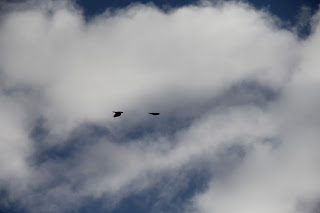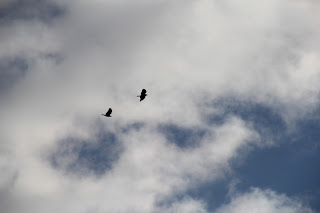The first photograph comes from a post I made back on January 13th. It shows a miniature forest of Wild Leek stalks and tree seedlings poking up through snow at Chipp-A-Waters Park in Mt. Pleasant. I like the stark, almost abstract quality that this image has.

The second photograph come from February 25th. The night before saw about 8 inches of snow dumped on Mid-Michigan and caused all local schools to be cancelled. I paused for a moment while shoveling out to take this photo of the sun trying to cut through the overcast sky. The snow covered branches belong to a large Honey Locust tree right outside my back door.

Some of my favorite photographs are a bit more abstract than others. This picture was taken at Dow Gardens in Midland on March 30th. Every year Dow Gardens hosts an exhibit called Butterflies in Bloom in their conservatory - the 2017 Butterflies in Bloom exhibit is scheduled for 03 March through 16 April. Shara and I attend every year to see and photograph the butterflies. There are often so many people packed into the conservatory that it is almost impossible to get good pictures of the butterflies. I often find myself spending more time taking pictures of the tropical plants than I do of the butterflies. I especially liked the fan-like leaves of this plant.

The next picture comes from Mill Pond Park on April 14th. I don't spend a lot of time photographing birds. I generally lack the patience required to be a birder (and frankly most birds don't excite me all that much) so I spend very little time looking for birds. However, there are times a bird shows up that just demands to be photographed. Although not a rare bird, and becoming quite a nuisance in many places, the Canada Goose is an attractive bird. This goose was casually swimming around the pond and approached quite close, which allowed my to take a large number of portraits of it.

This next picture might be my favorite image from the entire year. I frequently take students out into the woods to study trees and learn about forestry. Although I have been bringing students from Winn Elementary to the Chippewa Watershed Conservancy's Audubon Woods Preserve for several years, this was the first year that I have ever brought students from the Saginaw Chippewa Academy to this location. While measuring tree diameters, some of the students found this Grey Tree Frog hanging out on the bark of one of the trees. I love how this frog just disappears on the bark - camouflage is an awesome adaptation! This images dates from May 17th and appeared in a post the next day.

I take thousands of photographs every year. Most of them never make it onto this blog. That doesn't mean that I don't like them or that they aren't good photographs. Sometimes I just don't have time to write about everything I want to. This year a disproportionate number of my posts were about wildflowers so other subjects often went untouched. Back on June I spent several days meeting students at various ponds and rivers to sample aquatic invertebrates. None of the photos ever showed up on this blog. One of my favorite pictures was this one from June 7th of a student from Shepherd Elementary holding a small Wood Frog that she found along the Little Salt River. Why do I like this photo? The contrast of the pink sweatshirt with the greens and browns of the frog - girls rock at science!
I spend a significant part of July away from Mid-Michigan. I attended the Michigan Department of Natural Resources 2016 Academy of Natural Resources. Later in the month, Shara and I traveled through parts of four states while on vacation. My favorite photo from the month isn't necessarily a great picture, but it documents my favorite place that we visited during our travels - Great Serpent Mound.
Great Serpent Mound is what is known as an effigy mound - this means it
is an earthen mound created in the shape of a person, animal, or symbol. It is the largest effigy mound in the world. It measures approximately
just over a 1/4 mile long (1348 feet) and is several feet tall. When you remember that this was constructed entirely by hand using wood,
stone, and bone tools the achievement of its construction becomes even
more remarkable. The exact age of Great Serpent Mound is unknown. Several burial mounds on the site date from Fort Ancient Culture (1000 - 1500 AD) and the earlier Adena Culture (800 BC - 100 AD). Great Serpent Mound probably dates to one (or both) of these cultures as it was likely rebuilt several times over its history.

The next photograph was taken the morning of August 22nd. It shows a band of low clouds rolling across the landscape. This unusual cloud formation is known as an arcus cloud and is usually associated with thunderstorms, but can also occur when a cold front passes through. This specific type of arcus cloud is known as a roll cloud, because it appears to be rolling through the sky completely detached from all other clouds.

If you haven't figured it out by now, I am sharing one photograph from each month of the year. September is the time that the school gardens really their stride. Almost everything is in bloom and many pants are starting to develop their seeds. Back on September 14th and 15th I spent some time photographing the native pollinator gardens at the Saginaw Chippewa Academy and Winn Elementary. This picture of Butterflyweed s my favorite garden photograph of the year and a strong contender for my favorite photo of 2016. I love the full exploding fluffiness of the ripe seeds bursting from the pod to the right and how it contrasts with the still closed pods to the left of the photo.

October was one of the toughest months to pick a favorite. I had lots of images of fall color to choose from. Instead I picked this picture of the sunrise from October 26th. I often lament the fact that Mid-Michigan does not have any dramatic landscapes, but if you look hard enough there is still drama to be found.

November was one of the most difficult months from which to choose a favorite photograph - photos of leaves and tree trunks, the full moon, Lake Michigan, etc.. The photograph I chose was an instant favorite. It shows three fourth-grade students from Vowles Elementary posing during a woodland ecology activity at the school. Why do I like this photo? It reminds me of the painting The Son of Man by René Magritte. It shows the students, but the leaves hide their identities. As soon as one of the students picked up a large leaf I thought of posing them like this. I rarely ask people to pose in photos, but I like the results in this image.

December was probably my lightest month of the year for photography. I hardly took any photographs - I know the month isn't over so I have a few more chances. My favorite picture of the month is sort of an abstract one - it shows ice pans covering the surface of the Chippewa River at Mill Pond Park on December 14th. Although I shared several photos from this date, this picture was not one of them. Is it s great photograph? No. Is it even a good photograph? Probably not, but I like how it shows how small pans of ice come together to eventually cover the river with a layer of ice. I started this list with a winter scene and bookended the year with another winter scene.









































